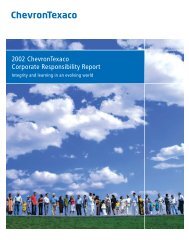Chevron Corporate Responsibility Report 2009
Chevron Corporate Responsibility Report 2009
Chevron Corporate Responsibility Report 2009
You also want an ePaper? Increase the reach of your titles
YUMPU automatically turns print PDFs into web optimized ePapers that Google loves.
Environmental Management<br />
Environmentally Sound Development<br />
<strong>Chevron</strong> develops energy with a commitment to protecting the environment.<br />
Our workforce embodies this commitment by developing new projects in an<br />
environmentally sound manner and continually improving the environmental<br />
performance of existing operations.<br />
Our environmental stewardship is managed<br />
through our Operational Excellence<br />
Management System, which has processes<br />
that examine life-cycle impacts, from<br />
initial assessments to site closure and<br />
transfer. Together, these processes systematically<br />
drive improvements in safety,<br />
health, the environment, reliability and<br />
efficiency.<br />
Impact Assessment<br />
<strong>Chevron</strong> performs a risk-based Environmental,<br />
Social and Health Impact<br />
Assessment (ESHIA) on all major capital<br />
projects to identify potentially significant<br />
project-related impacts. These include<br />
impacts to surrounding communities,<br />
natural resources, biodiversity, air quality,<br />
land use, waste management, noise<br />
and public health. ESHIA also identifies<br />
opportunities for avoiding, reducing and<br />
mitigating potentially negative impacts<br />
and for enhancing project benefits.<br />
The process is iterative and requires<br />
engagement with and input from key<br />
stakeholders through the project’s life<br />
cycle. Since its inception, the ESHIA<br />
process has been applied to more than<br />
690 capital projects worldwide.<br />
In one such project in northern Colombia,<br />
<strong>Chevron</strong> extension facilities for gas<br />
pro duction were planned to be situated<br />
in Wayúu territory. The Wayúu tribe is the<br />
largest Colombian indigenous group, with<br />
nearly 120,000 non-Spanish-speaking<br />
people. As part of <strong>Chevron</strong>’s ESHIA process,<br />
the project team learned that the<br />
proposed site was near the community’s<br />
water reserves and pathways used to<br />
reach the ocean.<br />
By changing site plans, the company<br />
received the required environmental<br />
permits on schedule and established the<br />
foundation for a constructive relationship<br />
with all the stakeholders. To strengthen<br />
this relationship, the company invited<br />
16

















